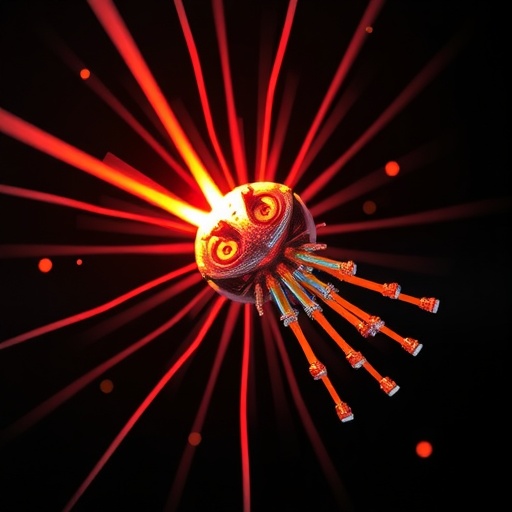In a groundbreaking advancement in the realm of nanotechnology, researchers at Concordia University have achieved a remarkable feat by developing the first micromotors capable of self-propulsion through air using solely light as a power source. This innovative technology harnesses the unique properties of tiny, pollen-shaped micromotors that measure approximately 12 microns in width, equivalent to one-tenth of the thickness of a human hair. Constructed from zinc oxide and meticulously coated with gold, these microscopic motors demonstrate that it is possible to attain controlled flight without the reliance on traditional fuel sources or batteries.
When exposed to a beam of near-infrared light, these micromotors absorb energy via the gold coating, which subsequently heats the adjacent air. This heat-induced energy transfer generates soft convection currents, akin to the uplifting of warm air, thereby propelling the micromotors upward and enabling precise directional movement. Researchers can effectively steer these tiny devices by manipulating the position of the light source, showcasing an impressive level of control that has previously been unattainable in airborne micromotor technologies.
Historically, micromotors have been restricted to motion in liquid environments, where buoyancy lends support to their movement. However, achieving controlled propulsion in air presents far more complex challenges due to gravitational forces alongside the absence of supportive fluids. The team’s success in overcoming these obstacles signifies a pivotal leap in the design and application of micromotor technologies, which could potentially revolutionize a variety of fields ranging from environmental sensing to micro-aerial delivery systems.
The leader of this innovative research initiative, John Capobianco, is a professor emeritus at Concordia University, specializing in the fields of chemistry and biochemistry. Capobianco has dedicated his academic career to advancements in nanoscience, and his recent work with these micromotors marks a high point in his research endeavors, particularly as he approaches retirement in May 2025. His contributions have not only shaped the future of nanotechnology but have also paved the way for new methodologies in experimental physics.
This groundbreaking research has been published in the esteemed journal Advanced Materials, signaling the importance and relevance of the findings to the scientific community. The research received crucial funding from the Natural Sciences and Engineering Research Council of Canada (NSERC) and CMC Microsystems, backed by the Government of Canada’s FABrIC project, which supports innovative research in the fields of materials science and engineering. The collaboration demonstrates a unified effort among various academic and governmental institutions dedicated to promoting scientific progress.
The implications of these light-activated micromotors extend well beyond mere academic curiosity—their potential applications are numerous and varied. For instance, these devices could be utilized in creating microscopic sensors that can detect environmental pollutants, thus contributing to efforts aimed at improving air quality. Additionally, the technology could lead to the development of nanomachines that perform targeted tasks in the atmosphere, such as delivering therapeutics for airborne diseases or monitoring climate phenomena at an unprecedented scale.
Moreover, understanding how these micromotors operate at the nanoscale opens avenues for further research into other potential light-driven technologies. The intrinsic relationship between light and matter at the nanoscale could provide new insights into energy efficiency, offering environmentally friendly solutions to energy acquisition, especially in areas where traditional energy sources are either impractical or unsustainable.
With the ever-growing focus on sustainability and the environment, these micromotors represent a new frontier in ecological technology. The ability to navigate and manipulate particles in air without chemical fuels not only promises a decrease in pollution outputs associated with powered movements but also aligns with broader goals of developing green technologies. This innovation stands to inspire further exploration into similar mechanisms that could convert light into motion, fostering a renewed interest in photonics and materials science.
As the authors of the study declare no conflict of interest, it underscores the integrity and motive of research aimed solely at benefiting society. This transparent approach cultivates an environment of trust and accountability within the scientific community, fostering collaborations that prioritize innovation and discovery. The nexus of collaboration between academia and funding bodies further signifies a commitment to scientific integrity and the drive to address global challenges.
Moving forward, it will be essential to investigate the scalability of this technology, evaluating the potential for developing larger or more efficient micromotor systems. The challenges of scaling nanotechnology often lie in the complexity of replicating nanoscale conditions at a larger scale while maintaining functionality. Understanding these limitations will be crucial for translating laboratory successes into real-world applications.
In summary, the creation of light-activated micromotors that operate in air presents a transformative opportunity within the realms of both nanotechnology and environmental science. As research continues to unfold and applications are explored, the potential for these micromotors to influence a wide array of industries becomes increasingly apparent. As we witness the advancement of technology that harnesses the power of light, we stand on the cusp of a new era in engineering and environmental sustainability.
Subject of Research: Micromotors powered by light for use in air
Article Title: Light-Activated Micromotors in Air Propelled by Thermal Convection
News Publication Date: 18-Sep-2025
Web References: Advanced Materials
References: DOI: 10.1002/adma.202505959
Image Credits: Image courtesy Impact Research Comms, created for Wiley for the publication in Advanced Materials
Keywords
Nanotechnology, Micromotors, Air Pollution, Environmental Science, Green Technology, Photonics, Energy Efficiency
Tags: airborne nanotechnology innovationschallenges in airborne propulsionConcordia University research advancementscontrolled flight without fuelconvection currents in micromotorslight-driven micromotorsmicroscopic motor technology breakthroughsnanotechnology and environmental sustainabilitynear-infrared light propulsionself-propulsion micromotorssteering micromotors with lightzinc oxide gold-coated motors





